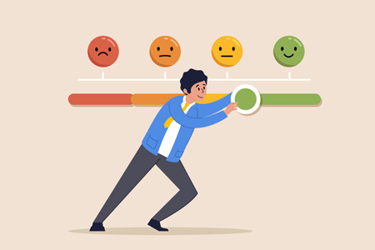Channel Your Inner Child To Become A Better Clinical Research Professional
By John R. Nocero, Ph.D., & Andrea L. Bordonaro, MAT

It takes a lifetime to develop a reputation and five minutes to destroy it: an administrator spends 10 years clawing his way up the clinical research ladder, only to become emotionally unglued in front of his team and explode in a fury of expletives when it doesn’t perform. OK, maybe that is a harsh example. Maybe it’s a CRC who talks to his PI a little too sternly when questioned about why he couldn’t enroll a patient who obviously met the study’s inclusion criteria. In both instances, a professional relationship is slightly fractured at best, totally obliterated at worst. The widespread effects could be crippling to a clinical research site. It is a critical point to make but it is also an obvious one — sites, CROs, and sponsors cannot have contentious relationships. Hard skills are often soft skills. Emotional regulation is an additional soft skill to be added to the toolkit to strengthen the relationship between all parties in addition to the hard skills of fundamentally sound operations and quality departments.
In the stressful and sometimes overwhelming world of clinical research, becoming totally overwhelmed by your emotions can happen to all of us — crying uncontrollably, snapping at others, or running away from a stressful situation. Emotions are your brain’s way of telling you something good or bad is happening in your life. Self-help author Mark Manson has a wonderful analogy when it comes to dealing with your emotions: “Experiencing an emotion is kind of like going through high school. When you’re in it, nothing feels more important. But when it’s over, you’re left wondering what it was all about.”
We’re not telling you emotions are bad or good. They just are. But emotions become a problem when you don’t have a healthy way to manage them. To emotionally regulate yourself means that you have the ability to step back from whatever emotion you are experiencing, identify it, and manage it as needed. But what if we told you there was a simple approach to name your feelings, resulting in increased self-awareness and improved social and emotional skills? It’s an approach that has been taught in schools around the world for more than 15 years and bringing it into the clinical research world can result in better relationships with your colleagues. It’s emotional intelligence on steroids — The Zones of Regulation.
What Are The Zones Of Regulation?
Occupational therapist Leah Kuypers created The Zones of Regulation as a roadmap to help kids organize their feelings and states of alertness and energy and for teachers and caregivers to support kids who struggle with emotion regulation. The four zones are organized by colors: blue, green, yellow, and red.
The blue zone is the lowest-energy zone. You may be in the blue zone when you are tired and ready to go to bed, or maybe when you are bored and looking for something to do. If you are in the green zone, you are feeling neutral, calm, content, or focused. If you are in the yellow zone, you have a bit higher energy and maybe you even feel anxious or fidgety. If you are in the red zone, you are at your most intense and emotionally heightened state, like all your senses are on fire. You may feel extremely elated, afraid, even panicked.
One of the key elements of the four zones is that they are simply a way of naming feelings. No color or zone is inherently better or worse than the other, which is why we believe in it — it helps you identify where you are right now with your feelings, without getting too high or too low. Each zone is also thought of as needing different tools for regulation, support, or feelings for management. If you are in the blue zone, you might need to snuggle a loved one or to stand up a bit and stretch. If you are in the green zone, you may want to stay there for an extended period of time, so meditation might be the tool you need. Some yellow zone tools include taking deep breaths, introducing positive self-talk, and connecting with someone for support. An effective tool for the red zone may be deep breathing or physical activity, such as running or yoga.
Zones Of Regulation In Practice
This method, although developed for children, also works for adults because Kuyper’s methods pull both theoretical and practical techniques from mindfulness practices — how past, present, and future moments shape future trends and our interpretation of them — and cognitive behavioral therapy, which is behavioral treatment that reveals the relationships between beliefs, thoughts, and feelings and the behaviors that follow. In other words, a person’s thought process informs their behaviors and actions. People learn that their perceptions directly influence how they respond to specific situations. It helps people problem solve. To think of this as a kid’s tool undermines the benefits that adults have by playing with Legos — promoting mindfulness and critical thinking.
Now, we may not be able to stop difficult situations from occurring, but by using the zones, we can change how we respond. For example, based on our previous examples, an administrator becoming unglued can identify himself in the red zone and take the steps to calm himself before attempting to respond to what is happening, by counting down from five to one or by stepping away from the situation. A CRC can avoid talking to a PI inappropriately by delaying a conversation until he/she has had a chance to calm down.
Now these steps may not be enough to reverse a difficult situation or make the problem go away, but by calming down before responding, one is more able to cope with the situation from a less emotional and more thoughtful, mindful place. Most importantly, one doesn’t have to undo a situation that escalated in the first place.
Conclusion
Emotions are a means to an end. They are here to help us achieve our goals and find a sense of purpose. They are not the purpose themselves. They happen, and then they are gone. If you base your life around them, you will be up, down, all around, running in circles, contradicting yourself, all in an effort to stay sane. And let’s be honest, no one can realistically live like that.
The point is, by using the zones of regulation, we get to decide what they mean for us as individual people with specific needs, and how we can accurately respond accordingly.
Key Takeaways
- Emotions do matter. In fact, they are incredibly important. They are a means to an end, helping us find purpose and achieve goals.
- The Zones of Regulation give us a concrete strategy to maintain emotions in a variety of situations.
- Learning to recognize and regulate our own emotions each day is beneficial in both our personal and professional lives. When we can easily identify our zone as we navigate our day-to-day, we are able to recognize and utilize effective strategies to move us to a more comfortable, successful, and positive place. In turn, we can then make better decisions and improve our interpersonal relationships, as well as feel better about the aura that we put forth about ourselves, which has a direct impact on how others view and interact with us.
- Use your next team meeting to introduce the Zones of Regulation to your research staff or use it as an employee engagement activity. This type of employee engagement — the connection that an employee has with their team, the job they do, the company culture and the company itself — can have real impacts on productivity and wellbeing.
References:
- What Are The 4 Zones of Regulation & Do They Really Work? (romper.com)
- How to Understand Your Emotions (markmanson.net)
- The Zones of Regulation | A Curriculum For Emotional Regulation
- Emotional Meltdowns: Why They Happen and How to Prevent Them (everydayhealth.com)
About The Authors:

 John R. Nocero, Ph.D., and Andrea L. Bordonaro, MAT, blog on LinkedIn as “The Q-Kids,” discussing everything related to clinical research education, inspiration, and professional connection. John is the director of compliance at Segal Trials in Miami Lakes, FL, responsible for all things clinical research operations, quality, regulatory, education, training, and compliance. He has worked in clinical research since 2003 and is inspired by the Irish professional wrestler Becky Lynch, whose personal and professional story centers on achievement, tenacity, grit, and overcoming adversity. He spends his time in offices and gyms between Miami; Durham, NC; and Columbus, OH. Andrea has been teaching first grade in the Willoughby-Eastlake School System for 25 years. In fact, she teaches in the very same classroom that she attended as a first grader. She earned a Bachelor of Science in elementary education from John Carroll University and master’s degree in the art of teaching and education from Marygrove College. She lives in Willoughby, OH.
John R. Nocero, Ph.D., and Andrea L. Bordonaro, MAT, blog on LinkedIn as “The Q-Kids,” discussing everything related to clinical research education, inspiration, and professional connection. John is the director of compliance at Segal Trials in Miami Lakes, FL, responsible for all things clinical research operations, quality, regulatory, education, training, and compliance. He has worked in clinical research since 2003 and is inspired by the Irish professional wrestler Becky Lynch, whose personal and professional story centers on achievement, tenacity, grit, and overcoming adversity. He spends his time in offices and gyms between Miami; Durham, NC; and Columbus, OH. Andrea has been teaching first grade in the Willoughby-Eastlake School System for 25 years. In fact, she teaches in the very same classroom that she attended as a first grader. She earned a Bachelor of Science in elementary education from John Carroll University and master’s degree in the art of teaching and education from Marygrove College. She lives in Willoughby, OH.
